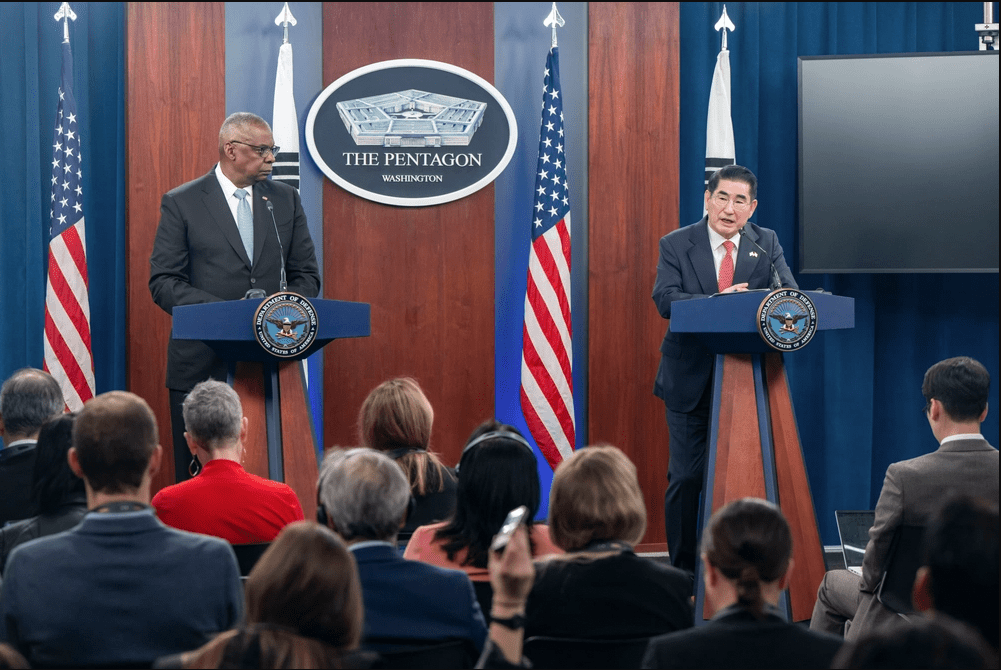Originally published U.S., South Korea move to enhance their militaries’ technology partnerships on by https://defensescoop.com/2024/10/30/us-south-korea-move-enhance-military-technology-partnerships/ at DefenseScoop
Close
At the Pentagon on Wednesday, defense leaders also discussed concerns around “destabilizing” cooperation between Russia and North Korea.
Listen to this article
0:00
Learn more.
This feature uses an automated voice, which may result in occasional errors in pronunciation, tone, or sentiment.

Top U.S. defense officials met with their closest South Korean counterparts on Wednesday at the Pentagon, where they pledged to deepen their militaries’ joint technology pursuits in new ways and discussed options for countering North Korea’s recent deployment of thousands of soldiers to support Russia.
The engagement marked the 56th U.S.-Republic of Korea Security Consultative Meeting.
Shortly after that SCM, Secretary of Defense Lloyd Austin and ROK Minister of National Defense Kim Yong-Hyun briefed reporters on plans to co-modernize their weapons arsenals and promote regional security endeavors in and around the Indo-Pacific.
“Moving forward, we’ll build on our momentum. And we’ll expand the scope and scale of our cooperation. We’ll use our strategic advantages and innovation in our defense industrial bases to bring cutting-edge tech to our warfighters,” Austin said.
In the meeting, the defense chiefs agreed to launch a new Regional Cooperation Framework covering a range of deliberate focus areas, including maritime security, multilateral exercises, capacity building, technical and defense industrial cooperation and information-sharing.
“Sec. Austin and I pledge to strengthen cooperation in science and technology and defense industry, based on the defense vision of the alliance. We plan to establish a vice minister-level Defense Science and Technology Executive Committee within this year to explore the application of cutting-edge science and technology in the defense sector,” Kim said through his interpreter.
Kim also confirmed that that new committee — the DSTEC — will puzzle out ways for South Korea to link with the AUKUS alliance on certain Pillar 2 projects to collaboratively accelerate emerging and disruptive military capabilities. The committee is envisioned to guide defense innovation and adoption of next-gen assets associated particularly with autonomous systems, artificial intelligence and quantum technologies.
“We acknowledge the significance of securing supply chain resilience and modernizing alliance capabilities, and pledged to engage in active cooperation in the defense industry sector,” Kim noted — pointing specifically to maintenance, repair and overhaul (MRO) activities and efforts designed to revamp weapons systems and make them more interoperable.
The SCM participants also deliberated on plans to upgrade their shared early warning systems and missile defense capabilities, to ultimately deter and respond to advanced and novel missile threats from North Korea.
Notably, this meeting unfolded against the backdrop of the Russia-Ukraine war that’s now at an extremely high risk of expanding to include involvement from that nation, also referred to as the Democratic People’s Republic of Korea, or DPRK.
“We’re closely tracking the unprecedented level of direct military cooperation between Russia and the DPRK. In our meeting today, we shared our deep concerns about the deployment of DPRK troops to Russia. We also discussed how we’re going to work together with our allies and partners to respond to this dangerous and destabilizing escalation. The evidence now suggests that North Korea has sent around 10,000 soldiers to train in eastern Russia. Some of these DPRK troops have already moved closer to Ukraine,” Austin told reporters.
“We’re seeing them outfitted with Russian uniforms and provided with Russian equipment. And I am increasingly concerned that the Kremlin plans to use these North Korean soldiers to support Russia’s combat operations in Russia’s Kursk region, near the border with Ukraine,” the secretary said.
Kim noted that he views that deployment as North Korean supreme leader Kim Jong Un’s “attempt to maintain his dictatorship.”
The dictator “didn’t hesitate to sell out his young people and troops as cannon-fodder mercenaries. I believe such activities [are] a war crime that is not only anti-humanitarian, but also anti-peaceful,” the South Korean defense minister said.
He expressed belief that it’s still possible for the U.S., South Korea and other partners to overcome this escalation. But Kim also warned that North Korea would likely move to garner higher-tech weapons from Russia as a trade for its troops.
“There’s a high chance that they would, in exchange for their deployment, North Korea is very likely to ask for technology transfers in diverse areas — including the technologies relating to tactical nuclear weapons, technologies relating to their advancement of [intercontinental ballistic missiles], regarding reconnaissance satellite, and those regarding [ballistic missile submarines] as well,” Kim said.
In response to a question regarding how he gauges possible threats of North Korea interfering with the upcoming U.S. presidential election, Kim told reporters he doesn’t currently view that as a major concern.
“However, I believe there is a high chance that they would want to exaggerate their existence [and alleged nuclear prowess] around the season of the U.S. presidential election — before and after the election,” the South Korean defense minister said.
On Thursday, Austin and Kim are set to join U.S. Secretary of State Antony Blinken and ROK Minister of Foreign Affairs Cho Tae-yul for a “2+2” foreign and defense ministers meeting.
More Scoops
Latest Podcasts
Originally published DefenseScoop

